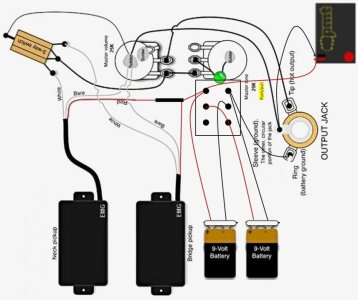alexreinhold
New member
Hi all, I am planning on wiring an 81/60 combo with a standard three-way switch. Instead of doing a full 18V-mod, I want to be able to switch from 9V to 18V by using a push/pull tone knob. I've read elsewhere that it's recommended to do this via series/parallel wiring (to drain batteries simultaneously I suppose?). I also want to install a PMT LoBat light indicator. Below you find the wiring diagram I prepared. I have three questions:
1. Is the wiring diagram correct?
2. Is there any risk to running batteries in series/parallel (note: it's the recommended way in another forum. But my physicist friend expressed doubts - though he wasn't sure)
3. Do you think the PMT LoBat will be able to account for the battery discharge correctly when wiring the batteries series/parallel?

1. Is the wiring diagram correct?
2. Is there any risk to running batteries in series/parallel (note: it's the recommended way in another forum. But my physicist friend expressed doubts - though he wasn't sure)
3. Do you think the PMT LoBat will be able to account for the battery discharge correctly when wiring the batteries series/parallel?

